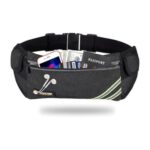Table of Contents
1. Introduction
Welcome to the fascinating world of heart rate monitoring during workouts with your tracker! Understanding how to effectively utilize this technology can truly elevate your fitness journey and help you achieve optimal results. By harnessing the power of real-time data on your heart rate, you can customize your workout intensity, track your progress accurately, and ensure that you are training in the most efficient way possible.
Your heart rate is a window into how hard your body is working during exercise. Monitoring it can provide valuable insights into your fitness level and overall health. With advancements in wearable technology, such as fitness trackers that offer continuous heart rate monitoring, keeping tabs on this vital metric has become easier than ever before. This guide will explore how to make the most of this invaluable tool to maximize the effectiveness of every workout session.
2. Understanding heart rate zones
Understanding heart rate zones is essential for maximizing the effectiveness of your workouts. Each zone represents a percentage of your maximum heart rate and serves a specific purpose. For example, the aerobic zone improves cardiovascular endurance while the anaerobic zone boosts performance. By monitoring your heart rate during exercise, you can ensure you are working within the desired zone to achieve your fitness goals more effectively.
Knowing your individual heart rate zones can also help personalize your workout routine. Tailoring exercises to target specific zones can prevent burnout and overexertion, ensuring steady progress without risking injury. Additionally, understanding how each zone correlates with different intensity levels allows for more structured training sessions, ultimately leading to better results in terms of both performance and overall health.
3. Setting target heart rate goals
Setting target heart rate goals is essential for maximizing the benefits of your workouts. By determining your maximum heart rate and then setting goals within a certain percentage range, you can tailor your exercises to suit your fitness level and objectives. For example, aiming to reach 70-80% of your max heart rate during cardio sessions can help improve cardiovascular endurance and burn calories efficiently. Moreover, tracking your heart rate in real-time using a fitness tracker allows you to make adjustments on the go to ensure you stay within your desired target zone.
Understanding the relationship between intensity levels and heart rate targets can enhance the effectiveness of your training sessions. Pushing yourself too hard by exceeding your target zone may lead to overexertion or injury, while staying below it might not provide enough stimulus for optimal results. Therefore, being mindful of where your heart rate stands during different activities can help you fine-tune the intensity of your workouts for better performance and progress tracking. Ultimately, setting achievable yet challenging target heart rate goals can positively impact both short-term workout effectiveness and long-term fitness gains.
In conclusion, incorporating target heart rate goals into your fitness routine will not only make your workouts more purposeful but also enable you to monitor progress more accurately over time. By utilizing this data-driven approach in conjunction with a reliable fitness tracker, you can make informed decisions about how to adjust variables such as duration and intensity levels for optimal results. Overall, setting personalized target heart rates empowers you to take control of your health and wellness journey by providing clear direction towards achieving specific fitness targets.
4. Monitoring during different types of workouts
When it comes to monitoring during different types of workouts, versatility is key. Whether you’re engaging in high-intensity interval training, endurance runs, or strength training sessions, your heart rate monitor can provide valuable insights into the effectiveness of your workout. For intense cardio workouts like HIIT, keep an eye on how quickly your heart rate spikes and the time it takes to recover between intervals. In contrast, for longer endurance activities such as a steady-state run, aim to maintain a consistent heart rate within your target zone.
During strength training sessions, monitoring your heart rate can help track how efficiently you are moving from one exercise to another and gauge overall exertion levels throughout the session. By analyzing your heart rate data post-workout across various types of exercises, you can tailor future workouts to optimize performance and better achieve fitness goals. Embracing technology like heart rate trackers opens up a whole new realm of personalized workout feedback that can elevate your fitness journey to new heights.
5. Interpreting data post-workout
Once your workout session is done and you have all the data at your fingertips, it’s time to dive into the numbers and make sense of what they are telling you. The post-workout data interpretation phase is crucial in understanding how effective your training was and determining areas for improvement. Look at trends such as your heart rate recovery time, peak heart rate achieved, and overall duration in different heart rate zones. This analysis will give you a comprehensive view of your performance and inform your future training decisions.
Furthermore, pay attention to any anomalies or unexpected patterns in the data that might indicate overtraining or an underlying health issue. If you notice consistently high heart rates or irregular fluctuations, it might be time to consult with a healthcare professional or adjust your training plan accordingly. Remember, data interpretation goes beyond just numbers – listen to your body’s cues and use the data as a tool to optimize rather than dictate your workout routine.
6. Tips for accurate heart rate tracking
1. To ensure accurate heart rate tracking with your fitness tracker, it’s vital to position the device correctly on your wrist. The tracker should be snug and positioned about a finger’s width above your wrist bone for optimal performance. Avoid wearing it too tight or too loose, as this can interfere with the sensors’ ability to detect your heart rate accurately.
2. Another tip is to pay attention to factors that may affect heart rate readings, such as environmental conditions and skin temperature. Extreme temperatures or excessive sweat can impact the accuracy of your tracker’s readings. Try to keep your skin dry and stay in moderate temperature settings during workouts to enhance the precision of the monitoring data collected by your device.
3. Lastly, it’s important to calibrate and update your fitness tracker regularly for improved accuracy in heart rate tracking. Calibration involves adjusting settings based on individual metrics like age, weight, and fitness level to ensure personalized monitoring. Additionally, check for software updates from the manufacturer that may include enhancements for more precise heart rate measurements during different types of exercises.
7. Conclusion: maximizing fitness results with tracking
In conclusion, tracking your fitness progress through heart rate monitoring is a powerful tool that can significantly optimize your workout routine. By using the data provided by your tracker, you can make informed decisions on how to adjust and fine-tune your training for better results. Understanding the correlation between heart rate zones and different workout intensities allows you to push yourself when needed or dial it back to prevent overtraining.
Furthermore, tracking not only helps in improving performance but also enhances motivation levels. Seeing tangible data of your progress can be a strong motivator to keep pushing towards your fitness goals. Remember that consistency is key – by consistently monitoring and analyzing your heart rate data, you will be better equipped to make smart choices that ultimately lead to more effective and efficient workouts. So, embrace the power of tracking and watch as it elevates your fitness journey to new heights!















